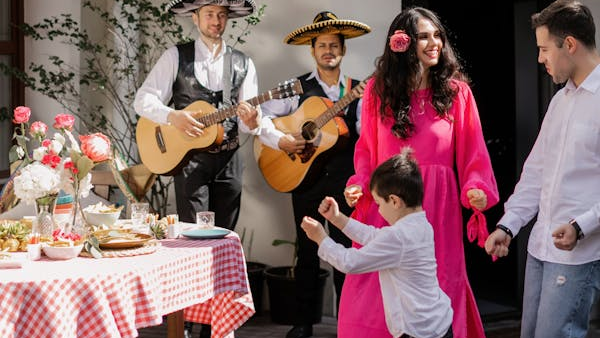
30 Latin American Spanish Idioms You Must Know to Sound Like a Native
Can you imagine being in the middle of a conversation with your Latino friends and suddenly someone says something that leaves you completely lost? Don’t worry, it has happened to all of us. Idioms are an essential part of any language, and knowing them will not only help you understand better but also sound like an authentic native speaker. Here we present 30 Latin American Spanish idioms that you need to know to impress your friends and connect more deeply with the culture.
Colombia

Colombia is a country known for its cultural diversity and friendly people. From the vibrant streets of Bogotá to the beaches of Cartagena, Colombian Spanish has a richness that makes it unique.
Key Colombian Idioms:
- Parcero or Parce: Means “friend.” Example: “¿Qué más, parcero?” (“What’s up, buddy?”)
- ¡Qué chévere!: Used to say something is nice or cool. Example: “¡Qué chévere, me encanta!” (“How cool, I love it!”)
- Pilas: Means to be attentive or prepared. Example: “¡Pilas con eso!” (“Be alert with that!”)
- Rumbear: Means to go partying. Example: “Vamos a rumbear esta noche.” (“Let’s go partying tonight.”)
- Jartera: Means boredom or annoyance. Example: “¡Qué jartera esta reunión!” (“This meeting is so boring!”)
In Colombia, the use of these idioms is everyday and reflects much of the local culture. For example, “parcero” is a word that symbolizes friendship and closeness between people. Using it will make you feel more integrated into conversations and allow you to establish more genuine connections with Colombians. Similarly, “rumbear” is an essential word in the vocabulary of anyone who wants to enjoy the vibrant Colombian nightlife. Additionally, “jartera” is perfect for expressing discontent in boring or tedious situations.
Argentina

Argentina is famous for its tango, delicious meat, and distinctive accent. From Buenos Aires to Patagonia, Argentinians have a way of speaking that is both passionate and unique.
Key Argentine Idioms:
- Che: Used to get someone’s attention. Example: “Che, ¿tenés la hora?” (“Hey, do you have the time?”)
- Boludo: Can be friendly or insulting depending on the context. Example: “¿Qué hacés, boludo?” (“What are you doing, dude?”)
- ¿Qué onda?: A casual way to ask “How are you?”. Example: “¿Qué onda?” (“What’s up?”)
- Laburo: Means “work.” Example: “Estoy en el laburo.” (“I’m at work.”)
- Mina: Used to refer to a girl. Example: “Esa mina es mi novia.” (“That girl is my girlfriend.”)
In Argentina, the idiom “che” is omnipresent and used in almost any context to catch someone’s attention. It’s an informal and friendly way to start a conversation. “Boludo,” though it may seem strong, among friends is an expression of camaraderie. However, it is important to understand the context to avoid misunderstandings. Additionally, terms like “laburo” and “mina” will help you better understand everyday speech and integrate more easily into Argentine society. These idioms reflect the relaxed and expressive way of communicating that Argentinians have.
Chile

Chile, with its unique geography ranging from the Atacama Desert to Patagonia, is a country of contrasts, and its Spanish reflects this. Chileans have a particular lexicon that can surprise those unfamiliar with it.
Key Chilean Idioms:
- Cachai: Means “do you understand?” or “do you know?”. Example: “Tienes que ir por esa calle, ¿cachai?” (“You have to go down that street, you understand?”)
- Bacán: Means “cool” or “fantastic.” Example: “¡Qué bacán, felicitaciones!” (“How cool, congratulations!”)
- Fome: Means boring. Example: “Esa película estuvo súper fome.” (“That movie was super boring.”)
- Pololo/Polola: Means boyfriend or girlfriend. Example: “Voy a salir con mi polola.” (“I’m going out with my girlfriend.”)
- Harto: Means a lot. Example: “Sí, me gustó harto.” (“Yes, I liked it a lot.”)
In Chile, “cachai” is one of those words you’ll hear very frequently, especially among young people. Using it correctly can make you seem like someone who truly understands the local culture. “Bacán” is another positive idiom you can use to express enthusiasm. If you don’t like something, “fome” is the perfect word to describe it. Additionally, terms like “pololo/polola” and “harto” are essential for talking about relationships and quantities, respectively.
Peru

Peru is a country rich in history, home to the ancient Inca civilization and modern wonders like Machu Picchu. Peruvian Spanish also has its own set of idioms that reflect its diverse culture.
Key Peruvian Idioms:
- Chévere: Means “cool.” Example: “¡Qué chévere, me encanta!” (“How cool, I love it!”)
- Pata: Means “friend.” Example: “Mi pata me ayudó a mudarme.” (“My friend helped me move.”)
- ¡Qué palta!: Means “how embarrassing!” Example: “Esta espera es una palta.” (“This wait is so embarrassing.”)
- Jamear: Means to eat. Example: “Voy a jamear algo.” (“I’m going to eat something.”)
- Jato: Means house. Example: “Nos vemos en mi jato a las ocho.” (“See you at my house at eight.”)
In Peru, the word “chévere” is widely used and conveys a positive and enthusiastic attitude. “Pata” is an affectionate way to refer to a friend, and using it will allow you to connect more deeply with Peruvians. If something bothers you, “¡qué palta!” is the perfect expression to complain colloquially. “Jamear” and “jato” are idioms that reflect daily life and will help you navigate various situations better.
Do you want to learn more about Latin America?
Mexico

Mexico is a country known for its rich culture, delicious cuisine, and vibrant music. Mexican Spanish is very expressive and has a large number of idioms that reflect daily life and the ingenuity of its people.
Key Mexican Idioms:
- ¡Qué padre!: Means “how cool!” Example: “¡Qué padre estuvo la fiesta!” (“The party was so cool!”)
- Chido: Means “cool” or “good.” Example: “Ese libro está bien chido.” (“That book is really cool.”)
- Güey: Used to refer to a person, similar to “dude” or “guy.” Example: “Oye, güey, ¿qué haces?” (“Hey, dude, what are you doing?”)
- Neta: Means “truth” or “seriously.” Example: “¿Neta no sabías?” (“Seriously, you didn’t know?”)
- Platicar: Means “to chat.” Example: “Vamos a platicar un rato.” (“Let’s chat for a while.”)
In Mexico, these idioms are part of everyday speech, and understanding them will allow you to communicate more naturally with Mexicans. “¡Qué padre!” and “chido” are very positive expressions you can use to show enthusiasm. “Güey” is a very common word among friends, and “neta” is perfect for confirming something with emphasis. “Chamba” and “platicar” are useful for work and social situations, respectively. These idioms reflect the warmth and ingenuity of Mexican culture.
Other Spanish Idioms in Latin America
- Ñaño (Ecuador): Affectionate way to say “brother.” Example: “Voy a salir con mi ñaño esta noche.” (“I’m going out with my brother tonight.”)
- Tiguere (Dominican Republic): Describes someone clever or smart. Example: “Ese tiguere siempre encuentra la manera de resolver todo.” (“That guy always finds a way to solve everything.”)
- Chavo (Puerto Rico): Means money. Example: “¿Tienes chavos?” (“Do you have money?”)
- Changuito (Bolivia): Used to refer to a small child. Example: “¡Mira ese changuito!” (“Look at that little kid!”)
- Chulina (Paraguay): Means pretty. Example: “¡Qué chulina está esa decoración!” (“How pretty is that decoration!”)
These idioms are clear examples of how Spanish varies in different regions of Latin America. Each word has its own flavor and cultural context, reflecting the diversity and richness of the language. Integrating these idioms into your daily vocabulary will not only enrich your Spanish but also allow you to connect more deeply with people from different countries.

How to Integrate These Idioms into Your Daily Vocabulary
So, how can you start using these idioms? Here are some strategies:
- Practice with native speakers: Don’t be afraid to make mistakes; practice makes perfect. Conversing with native speakers will allow you to learn the context and correct pronunciation of each idiom.
- Watch movies and series in Latin American Spanish: Pay attention to how the characters use idioms in different contexts. This is not only fun but also educational, as it helps you understand the nuances of the language.
- Read books or articles in Spanish: This will help you become familiar with the language and see how idioms are used in writing. Our short stories in Spanish are an excellent tool to improve your vocabulary and comprehension.
Benefits of Knowing and Using Idioms in Learning Spanish
Learning and using idioms will not only help you sound more natural but also allow you to better understand the culture and daily life of native speakers. Idioms are a window into how people think and communicate. Using them correctly will allow you to integrate better into any Spanish-speaking environment and make you seem like someone who truly understands the language and culture.
Discover More Idioms and Improve Your Spanish with Our Short Stories
As you can see, knowing idioms is a crucial part of sounding like a native and better understanding Latin American culture. Are you ready to take your Spanish to the next level? We invite you to explore our short stories in Spanish, where you can learn more about the language and practice with real examples.
Do You Want to Learn More About Latin American Spanish?
Explore our selection of books and resources designed to help you master Spanish from different regions. From Colombian slang to Argentine idioms, we have everything you need to speak like a native. Don’t miss out!ies is essential. Start practicing them today and enjoy richer and more authentic communication!
Do you want to learn more about Latin America?






